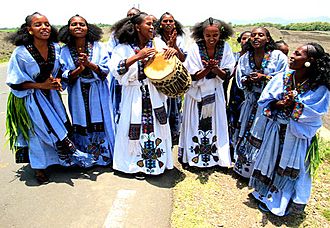Ashenda facts for kids
Quick facts for kids Ashenda |
|
|---|---|

Group of Agew girls with Habesha kemis celebrating Ashenda in Wollo
|
|
| Official name | Ashenda, Shadey, Ashendeye, Solel |
| Also called | Girls' Day |
| Observed by | Eritrea |
| Type | Cultural |
| Begins | 16 August |
| Ends | 26 August |
| Date | After ending of Filseta feast |
| Frequency | Annual |
| Related to | Filseta |
Ashenda is a special festival celebrated in Eritrea and parts of Ethiopia, especially by the Tigray, Amhara, and Agew communities. It's often called "Girls' Day" because it's a big celebration for girls and women of all ages.
Girls and women look forward to Ashenda all year. They spend months getting ready! They buy new clothes, visit hairdressers, and prepare drums. They also gather a special type of long, thin grass, which is also called 'Ashenda'. This grass is tied around their waists for the celebration. During this festival, everyone expects boys and men to be on their best behavior.
Ashenda started as a cultural holiday. Over time, it also became a religious one. Its roots can be traced back to ancient Israel, where Hebrew women celebrated holidays and victories. After Christianity came to Ethiopia in the 4th century AD, the celebration began to mix with Christian beliefs. Now, many people celebrate it to remember the Virgin Mary going up to heaven after her "Dormition" (which means "falling asleep" or passing away). This Christian feast is called Filseta. Ashenda is usually celebrated between August 16th and 26th each year.
Contents
How Ashenda is Celebrated
Visiting Homes and Dancing
On the first day of Ashenda, girls gather together. They make their way to the local Church of St. Mary or another Orthodox Tewahedo Church. They play music and dance as they go.
After visiting the church, the girls walk around the whole village. They visit each house to thank the families in the community. The Ashenda girls spend about 20 minutes at each home. They entertain the families with their music and dancing. Before they leave, families usually give them gifts. These gifts can be money, food, or drinks.
After visiting homes, the girls find a good field nearby. They spend anywhere from one day to a whole week dancing and playing in the field. If men pass by, they are encouraged to give gifts of money to the girls.
Gifts and Giving Back
All the money and gifts collected during the celebration are not kept by the girls. Instead, they are donated to a charity. Sometimes, the gifts go to the Church or are used for other community events. It's a way of giving back and helping others.
What Does "Ashenda" Mean?
The festival is named after the long, thin "Ashenda" grass. Girls tie this grass to their waists in a stylish way. The Ashenda grass has become a symbol of the festival. When the girls dance, they move their waists, which makes the grass leaves shake in a beautiful way.
The festival is also known by other names. These include "Shadey," "Ashendye," "Aynewari," and "Solel."
See Also
- Filseta

